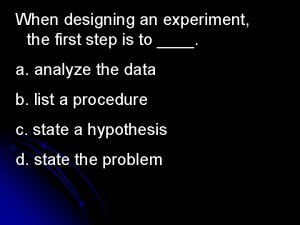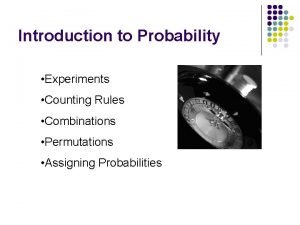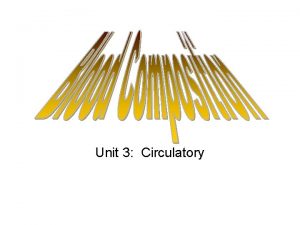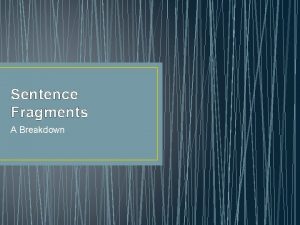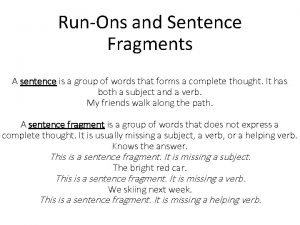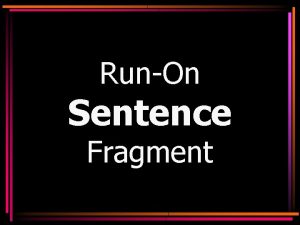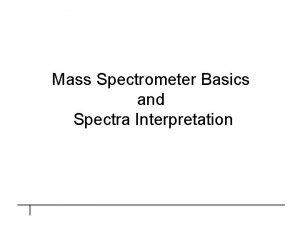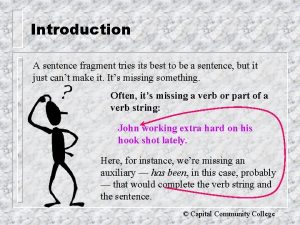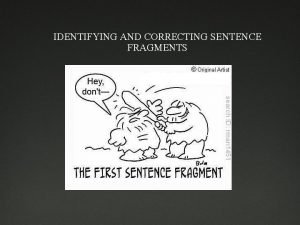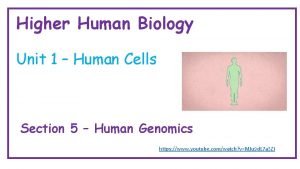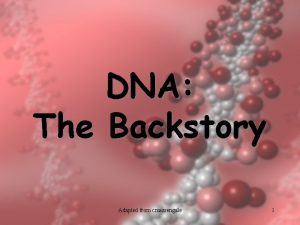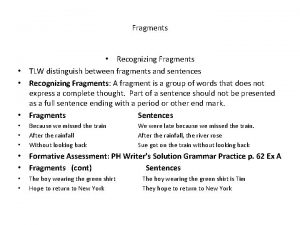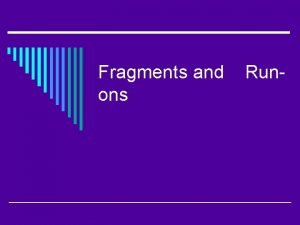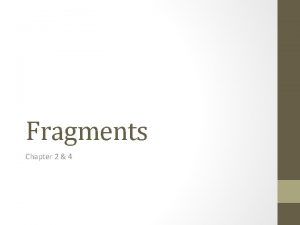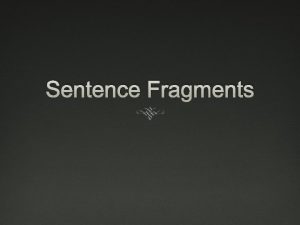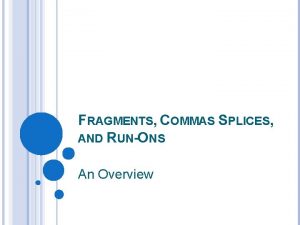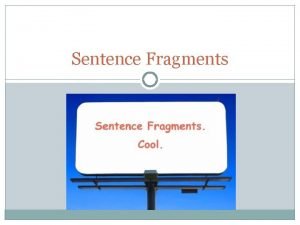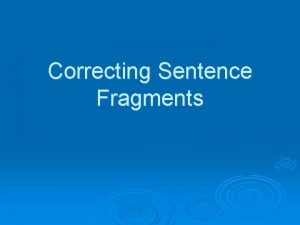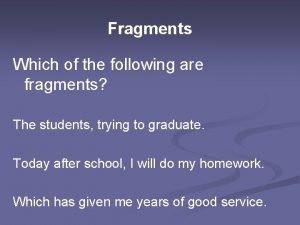Step 1 Design Experiment Step 2 Prepare Fragments











- Slides: 11

Step 1: Design Experiment Step 2: Prepare Fragments Designed your cloning experiment, primers? How do we generate and assemble the fragments? KLD Mutagenesis 1) PCR on template with two primers 2) QC on gel 3) Optional gel purification 4) KLD Reaction 2+ Fragment Gibson Assembly or Goldengate 1) PCR on destination vector to linearize 2) PCR (or synthesize) insert(s) 3) QC on Gel 4) Gel Purification / Spin Column purification 5) Assembly Reaction Step 3: Assemble Fragments Step 4: Transform Cells Step 5: Screen Colonies Do Stuff with Clones

KLD Mutagenesis Fragment Prep 1) Prepare PCR with: • Highly accurate polymerase (Q 5 or equivalent) • Long plasmids? GC Enhancer Buffer VERY useful • LOW template amount (0. 1 to 0. 5 ng plasmid/25 u. L PCR reaction) -> Make it easier for the Dpn. I 2) Thermocycling settings: Weak band? Bump up to 35 -40 cycles More cycles -> More non-specific bands Initial Denaturation: 95°C for 90 seconds 30 Cycles of: 95°C for 30 seconds 50– 67°C for 30 seconds 72°C for 30 seconds/kb Have a gradient PCR machine? 4 -6 reactions from 55 -67 °C No gradient PCR? Start at 59 °C and pray Final Extension: 72°C for 2 X Cycling Extension Time END LET THE PCR MACHINE COAST TO ROOM TEMP! PCR products can survive for DAYS at RT Your thermocycler is not a refrigerator!

KLD Mutagenesis QC 1) Run 5 -8 u. L of PCR product on a 1% agarose 2) Do I have a product of expected size? (*) 3) Is the PCR product pretty clean? Annealing Gradient * * Expected product + other bands? Optimize PCR Optimize Primers Pool Samples Gel Purify YOLO (Screen more colonies) KLD Reaction Noice and clean? No cleanup needed (usually) KLD Reaction

KLD Reaction - NEB’s KLD mix -> Nice, but $$$ - Homemade KLD mix -> Works great, assemble yourself (Thank you msr 2009/reddit for recipe) 1 ul PCR product or gel purified band (5 -10 ng total should do it) 1 ul 10 X T 4 DNA ligase buffer 1 ul T 4 PNK 1 ul T 4 DNA ligase 1 ul Dpn. I 5 ul H 2 O -----------10 u. L total Incubate at RT for 1 hour, transform 1 u. L of reaction/100 u. L comp. cells - That’s…it? If you’ve got a decent PCR product KLD reactions are pretty smooth.

Gibson/Goldengate 2+ Fragment prep 1) Prepare PCR with: • Highly accurate polymerase (Q 5 or equivalent) • Long fragments? GC Enhancer Buffer VERY useful • Shorter fragments? <2 -3 kb? May or may not need GC enhancer -> Lowers accuracy (a bit) • LOW template amount (0. 1 to 0. 5 ng/25 u. L PCR reaction) -> Make it easier for the Dpn. I 2) Thermocycling settings: Initial Denaturation: 95°C for 90 seconds 30 -40 Cycles of: 95°C for 30 seconds 50– 67°C for 30 seconds 72°C for 30 seconds/kb Have a gradient PCR machine? 4 -12 reactions from 55 -67°C No gradient PCR? Start at 59°C and pray Final Extension: 72°C for 2 X Cycling Extension Time END LET THE PCR MACHINE COAST TO ROOM TEMP! PCR products can survive for DAYS at RT Your thermocycler is not a refrigerator!

Gibson/Goldengate 2+ Fragment QC 1) Run 5 -8 u. L of PCR product on a 1% agarose 2) Do I have a product of expected size? (*) 3) Is the PCR product pretty clean? Annealing Gradient * * Noice and clean? Optimize PCR Optimize Primers Dpn. I treatment Less Risk Gel Extraction + Protocol Slower PCR Cleanup Riskier + Column Faster Assembly NO CLEANUP DO YOU FEEL LUCKY Expected product + Nonspecific? Dpn. I treatment Gel Extraction Protocol Assembly

- Gibson Assembly Determine concentration of all fragments with spectrophotometer Calculate fmol/u. L for all fragments (NEB Biocalculator -> ds. DNA Mass to Moles) 1 vector fragment, 1 insert? 1: 3 molar ratio 1 vector fragment, 1 small insert (100 -500 bp)? 1: 5 to 1: 10 ratio 1 vector, 2 or more fragments? 1: 1: 1 etc ratio Shoot for 200 fmol of all fragments combined, 50 fmol is grim but doable, 400+ fmol for 3+ fragment assemblies Which mix to use? 1 -4 Fragments? 1 -3 Fragments? 5 X TEDA Cloning Mix (1 m. L) 500 m. M Tris–HCl p. H 7. 5 (0. 5 m. L of 1 M stock) 50 m. M Mg. Cl 2 (50 u. L of 1 M stock) 50 m. M dithiothreitol (100 u. L of 0. 5 M stock) 0. 25 g of PEG 8000 (May need gentle heat) 1 μl of 10 U/μl T 5 exonuclease (NEB) Combine fragments + mastermix in 10 -20 u. L volume 30 C for 40 minutes 2 X Gibson Assembly Master Mix 405μl Isothermal Start Mix 25μl 1 M DTT 20μl 25 m. M d. NTPs 50μl NAD+ (NEB Cat. B 9007 S) 1μl T 5 exonuclease (NEB Cat. M 0363 S) 31. 25 μl Phusion High Fidelity DNA Polymerse (NEB Cat. M 0530 S) 250 μl Taq Ligase (NEB Cat. M 0208 S) 467. 75 μl H 2 O Mix by pipetting gently. Make 100 μl aliquots. Isothermal Start Mix 1. 5 g PEG 8000 3 ml 1 M Tris-HCl, p. H 8. 0 150μl 2 M Mg. Cl 2 Put on tube rotator until PEG is in solution 1 -4 Fragments? Commercial Gibson Mix (NEB or Other brands) Combine fragments + mastermix in 10 -20 u. L volume 1 -5 Fragments? Commercial Hi-fi Mix (NEB) Combine fragments + mastermix in 10 -20 u. L volume Recipe/Optimization by Ethan Ford -> Ethanomics blog 50 C for 60 minutes Combine fragments + mastermix in 10 -20 u. L volume 50 C for 60 minutes - Mix chosen depends on number of fragments to assemble and budget. Gibson/Hifi mastermix has a notoriously short shelf life! Even at -80 C

Golden Gate Assembly - Determine concentration of all fragments with spectrophotometer Calculate fmol/u. L for all fragments (NEB Biocalculator -> ds. DNA Mass to Moles) 1 vector fragment, 1 insert? 1: 2 molar ratio 1 vector, 2 or more fragments? 1: 2: 2… etc ratio Equimolar ratios can also be used Bsa. I-HFv 2 works best at 37°C, T 4 Ligase at 16°C, so we cycle the reaction 10 X T 4 DNA Ligase Buffer Vector (50 fmol) Insert(s) (100 fmol each) T 4 DNA Ligase Bsa. I-HFv 2 d. H 2 O Total - 2 u. L X u. L 0. 5 u. L X u. L 20 u. L Reaction 1 Cycle of: 37°C for 3 minutes 16°C for 6 minutes 25 Cycles of: 37°C for 1. 5 minutes 16°C for 3 minutes 1 Cycle of: 37°C for 6 minutes 80°C for 10 minutes END Other restriction enzymes may be substituted for Bsa. I-HFv 2, some require a 42°C incubation temperature Cycling increases efficiency of multi-fragment assemblies, 2 fragment assemblies may not need cycling (but doesn’t hurt) Cycling program can be as complex or simple as you want

Gel Purification Protocol 1) Pool PCR products from multiple reactions - Anywhere from 4 -12 reactions - “Can I gel purify 1 reaction? ” Sure, but expect low yield…good luck downstream! 2) Add 0. 5 -1 u. L of Dpn. I to pooled reaction per 100 u. L of PCR product -> 37°C for 1+ hours (Overnight is fine) 3) Desalt/concentrate digested PCR product with PCR Cleanup Protocol (Silica column cheat sheet) - Just concentrate PCR product and run on gel? -> Smear on agarose due to concentrated salt/buffer - Large volume difficult to load on low-melt agarose gel -> Diluted in gel volume - Silica column desalts AND concentrates pooled PCR product (Better than G 50 resin, trust) 4) Elute in 35 -50 u. L if you don’t have a Centrivap, elute in 100 u. L and concentrate to 35 u. L if you do 5) Load onto low-melt agarose with a blue-light reactive dye - Ethidium bromide + UV -> Damages DNA -> Longer DNA fragments = More damage/time - Don’t have a gel comb that will fit 35 -50 u. L? Tape a few lanes together 6) Cut out desired band under blue light and purify with silica column (Silica column cheat sheet) 7) Elute in 35 -50 u. L if you don’t have a Centrivap, elute in 100 u. L and concentrate to 35 -50 u. L if you do 8) Determine concentration of fragments with spectrophotometer: - Less than 10 ng/u. L? Dicey, but doable. Consider additional PCR reactions to bulk up concentration - 10 -30 ng/u. L? Good enough depending on size of fragments - 30 -100 ng/u. L? Comfortable amount for most applications - >100 ng/u. L? You’re laughing! Enough for repeats! MVP <3 I luv u

Assembly Controls? - More controls -> Easier to troubleshoot when things go wrong Difficult assembly? Do more controls KLD Mutagenesis Same reaction WITHOUT ligase 2+ Fragment Gibson Assembly or Goldengate Each Fragment by itself + Gibson assembly mix All assemblies Transform cells with known good plasmid, p. UC 19, p. Cambia, etc E. g. Vector alone, Fragment 1 alone… Tests for: - Dpn. I template degradation - Self annealing of fragments Tests for: - Bad plates - Bad antibiotics - Bad cells

Cloning Workflow Assembled your fragments? Time to transform! Step 1: Design Experiment/Fragments Step 2: Prepare Fragments Step 3: Assemble Fragments Step 4: Transform Cells Step 5: Screen Colonies Do Stuff with Clones KLD Mutagenesis 2+ Fragment Gibson Assembly*** or Golden Gate*** 1) 1 u. L KLD reaction / 100 u. L Comp. cells 2) Heat shock at 42°C for 30 s, Ice 2 minutes 3) Add 900 u. L SOC, Recover at 37°C, 250 RPM, 1 hour 4) Spin down, discard everything except 50 -100 u. L, resuspend and plate 1) 1 -3 u. L Gibson/Golden Gate reaction / 100 u. L Comp. cells 2) Heat shock at 42°C for 30 s, Ice 2 minutes 3) Add 900 u. L SOC, Recover at 37°C, 250 RPM, 1 hour 4) Spin down, discard everything except 50 -100 u. L, resuspend and plate *** PEG 8000 inhibits transformation, don’t transform more than 3 u. L! *** Electroporating E. coli or Agro? 1 -2 u. L max, high salt = more arcing! BAM! ***
 Step 1 step 2 step 3 step 4
Step 1 step 2 step 3 step 4 A girl whose weight is 500n hangs
A girl whose weight is 500n hangs Counting rules in probability
Counting rules in probability Platelets are fragments of multinucleate cells called
Platelets are fragments of multinucleate cells called Breakdown sentence
Breakdown sentence A fragment sentence
A fragment sentence Sentence fragments and run-on sentences
Sentence fragments and run-on sentences Mass spec fragments
Mass spec fragments Identifying sentence fragments
Identifying sentence fragments Identifying sentence fragments
Identifying sentence fragments Dna fragments can be separated by
Dna fragments can be separated by Okazaki fragments founder
Okazaki fragments founder

